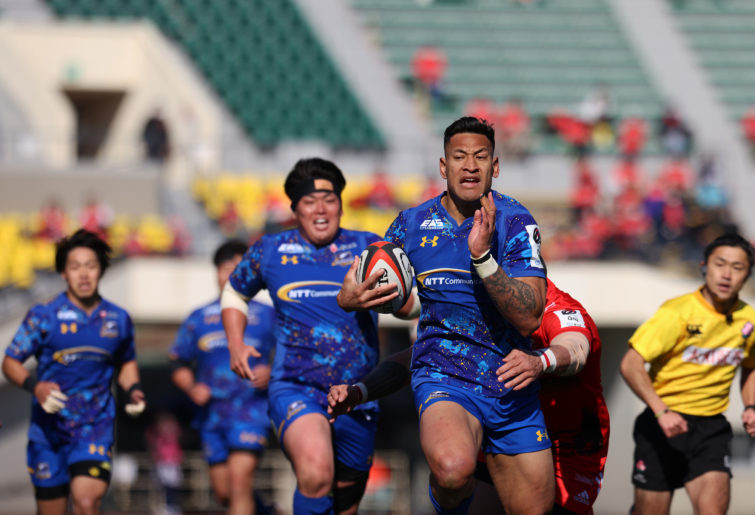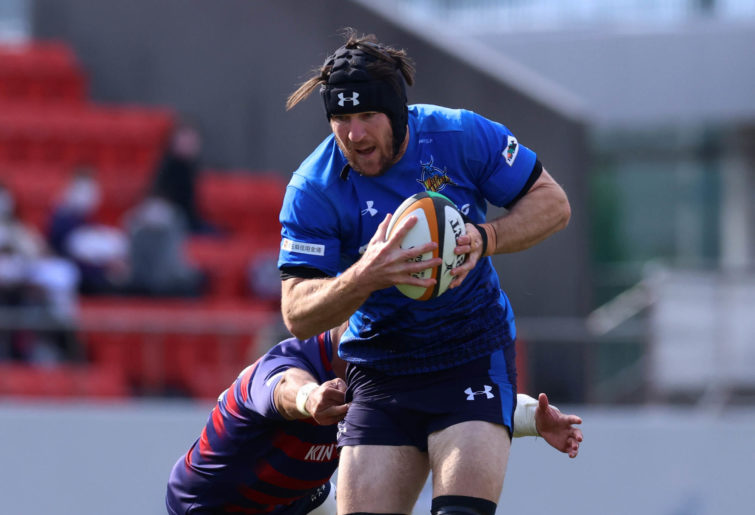“And we know, frankly speaking, there are some conflicts between those two regions currently, but as we all belong to the same time zone, we have the mutual benefit.”
It really was the perfect example of respectful Japanese understatement.
Mr Hajime Shoji, the CEO of Japan Rugby League One, had just explained to me that while his competition’s ambitions to set up some kind of cross-border competition with Super Rugby Pacific sides were well known, they were of the impression that Rugby Australia and New Zealand share those same ambitions.
Over the course of half an hour last week, it became clear to me that as soon as “some conflicts” between the trans-Tasman rugby siblings can be resolved, Japanese rugby is ready, willing and able to bring an Asia-Pacific take on the European cup-style tournaments to our timezones.
They’re essentially just waiting for the phone call.
Mutual contacts had put me in touch with Mr Shoji, and he was joined on a Zoom call by JRLO chairman Mr Genichi Tamatsuka in an opportunity to push their cross-border aspirations into the Australian rugby space once again.
It was a topic I was intrigued by when first suggested to me and I’m no less intrigued having now had the conversation with two of the most influential names in Japanese professional rugby. And I wasn’t the first, because the first few seconds of research returned articles on Australian websites from less than six weeks ago.
Not only are Mr Tamatsuka and Mr Shoji happy to play the waiting game to achieve their cross-border goals, they’re also happy to discuss that patience and those ambitions as often as possible.
“We don’t know precisely the situation for the Super Rugby future and what kind of decisions people will make, however one thing that’s very obvious for us is that we need a cross-border type of competition to push up our quality of the league,” Tamatsuka told AAP last month in an interview that featured on the Australian ESPN rugby site, as well as stuff.co.nz over the ditch.
“We continuously discuss with the many unions, other foreign leagues, and we aggressively seek the opportunity.”
Curious as to just how aggressively this opportunity is being sought, Tamatsuka expanded on this for me.
“In terms of Asia, Japan Rugby League One is the only league,” he said.
“On the other hand, from an economy point of view, and from a population point of view, Asia is the growing centre for the global economy.
“So in that sense, we feel a big potential for League One not only in Japan, but also for the global market. So we are very positive and very interested in having the cross-border competition with the great Southern Hemisphere teams, and also European teams.”

Israel Folau runs during his first game in Japan’s League One. (Photo by Buddhika Weerasinghe/Getty Images)
Shoji took this a little further, breaking the cross-border opportunity down into three main avenues: Japanese rugby fans love international matches and competition for one; cross-border competition drives JRLO clubs and players to higher standards for another; and the final one being arguably the biggest of all.
The same corporations that drove the Top League and continue to sponsor League One teams want to sell as many cars, mobile phones and household electronic goods in Australia and New Zealand as they can.
“That’s quite an important point of view,” he said.
“Partners or parent enterprises of League One teams, those are very prestigious or established Japanese corporations with global business, and for them, more fans in the global market to League One is of course desirable.
“They are also quite happy to increase their presence in New Zealand and Australia through rugby.”
As ever, that nagging little detail that is the global rugby calendar fast becomes a factor when trying to establish at what time of year this kind of competition could take place. Almost certainly, it would require a shortening of Super Rugby and League One may need one as well, if an earlier start isn’t feasible.
Timing is clearly a major point of discussion, as are competition format and broadcast options. But from a JRLO perspective, those discussions remain ongoing and just part of the journey to a resolution.
“After the League One finals, we may have the (northern) summer championship in Asia-Pacific and where maybe two or four teams from Japan will be participating as well as teams from Australia and New Zealand,” Shoji said.
“And of course, the broader participation from the Pacific Islands should be welcomed, however the challenge is of course the calendar. We should put everything in the summer, a limited time, maybe end of May or June, given the calendar of the international teams.
“So therefore, how to realise the balance, or how to realise the good calendar to find room for the league games and international games, that should be the point of the discussions.”
This mirrored my own thoughts from back at the end of May, where I suggested that May-June period before the July Tests was the window that made the most sense.
Tamatsuka has been enthused by the quality in the initial seasons of League One, relative to where the Top League was. The ability for teams to nominate which division they first entered has seen teams find their level, generally speaking, while promotion and relegation remains an important component through the three divisions.
“We have to clarify a little bit, for each division, the purpose,” he said. “Maybe for Division 1, should be really aiming up for global competition, to compete against the top teams in your country. So that should be the vision.
“Maybe Division 2 is slightly different. They should still be aiming for that, but maybe they are not yet capable. (The semi-professional) Division 3 is more a wide range of teams, and so on. So those things we are discussing.”
But he admits there might be a rethink needed around team names.
As League One was created, there was a desire to steer teams away from their corporate identities, in favour of names more reflective of their origins and regions.
The Panasonic Wild Knights became the Saitama Wild Knights and moved prefecture in the process. The NEC Green Rockets became the Green Rockets Tokatsu, while Yamaha Júbilo took a whole new identity, becoming the Shizuoka Blue Revs.

Daniel Heenan during his time at Panasonic Wild Knights. (Photo by Buddhika Weerasinghe/Getty Images)
The NTT Shining Arcs took rebranding further, becoming Shining Arcs Tokyo-Bay Urayasu for the first JRLO season, then changing again for this coming season to now be known as Urayasu D-Rocks.
“Some people are very used to Suntory Sungoliath, but they called themselves Tokyo SG,” Tamatsuka explained, before completely flooring me with what he said was a common source of confusion after the JRLO launch.
“The fans say, ‘Who the f**k is Tokyo SG?’” he laughed. I could only laugh with him, I didn’t see it coming.
“We need a little bit of adjustment, and maybe we don’t care if they use Canon or Suntory or so on. It’s clear then for the supporters.
“Many teams also are concentrated in the Tokyo area, everybody uses Tokyo, Tokyo, Tokyo… this is another confusion, so I think we need a bit of an adjustment.”
But whatever the teams have been called, or might be called in the future, Mr Shoji said he watches a lot of Super Rugby and is left with no doubt that JRLO teams are ready to compete.
“Yeah, we are watching a lot!” he said excitedly.
“But basically, sometimes the speed is definitely faster in Super Rugby, and on the other hand with scrums, in a unique Japanese way, might be not stronger, but definitely interesting. Different scrums in Japan.
“So therefore, more interaction between the two rugby regions should be enhancing the quality of rugby, or the excitement of rugby.
“That’s our impression after watching so many games of Super Rugby.”
And what about a timeframe for this ambition, I wondered?
Clearly there is much to talk about before an idea like this even gets to the stage of initial public announcement, let alone constructing things like formats and draws – not to mention the elephant in the room in the form of NZR and RA still trying to work out if they’re symbiotically connected or diametrically opposed.
It’s all well and good to talk to Australian and New Zealand writers, telling all and sundry that more Wallabies and All Blacks are wanted in the League One, but when might we see this idea of an Asia-Pacific championship?
“We don’t have a clear timeline, because this is depending on the situation of each market (in Australia in NZ),” Shoji said.
“However given our observations so far, maybe the timeline is waiting two or three years and in that I would like to see some sort of cross-border competition start in any format, even a smaller format.”
The timeframe might feel ambitious, but the desire for cross-border competition is certainly real, a sentiment echoed by NZR and RA in the past.
It feels like it will happen at some point, but perhaps the difficulty in saying that is how it progresses beyond that feeling, those shared desires, and a very clear Japanese ambition.






























































































